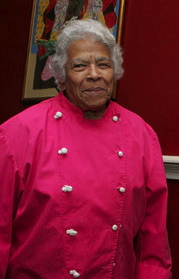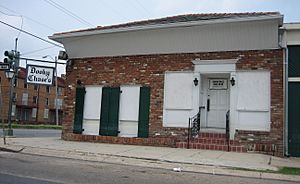Leah Chase facts for kids

Leah Chase in April 2008
|
|
| Born | Leyah Lange January 6, 1923 New Orleans, Louisiana, U.S. |
|---|---|
| Died | June 1, 2019 (aged 96) New Orleans, Louisiana, U.S. |
| Cooking style | Creole |
| Spouse | Edgar "Dooky" Chase II (m. 1946; died 2016) |
|
Current restaurant(s)
Dooky Chase
|
|
|
Award(s) won
|
|
Leah Chase (born Leyah Lange; January 6, 1923 – June 1, 2019) was a famous American chef from New Orleans, Louisiana. She was also an author and appeared on television. People knew her as the Queen of Creole Cuisine because she was amazing at making Creole food. She also strongly supported African-American art.
Her restaurant, Dooky Chase, was a very important place during the 1960s. Many people involved in the Civil Rights Movement met there. It was also like an art gallery because it had a huge collection of African-American art. In 2018, Food & Wine magazine called Dooky Chase one of the 40 most important restaurants of the past 40 years.
Leah Chase received many awards and honors throughout her life. In 2010, she was added to the James Beard Foundation's Who's Who of Food & Beverage in America. She also got a special lifetime achievement award from the Southern Foodways Alliance in 2000. Many universities gave her honorary degrees, which are special awards for her achievements. The Southern Food and Beverage Museum in New Orleans even named a permanent art gallery after her in 2009.
Contents
Early Life of Leah Chase
Leah Chase was born in New Orleans to Catholic Creole parents. She grew up in Madisonville, Louisiana. Her family background included African, French, and Spanish roots. Her father worked at a shipyard, and her grandmother was a nurse and midwife.
Leah was one of 13 children. When she was six, the Great Depression started, which was a very tough time. She remembered her family growing their own food like okra, peas, and greens to survive. They even made clothes from sacks that had held rice and flour.
Madisonville had separate schools for black and white children. There was no Catholic high school for black students in her town. So, Leah moved to New Orleans to live with relatives. There, she could go to St. Mary's Academy for her Catholic education.
Leah Chase's Early Career
After finishing high school, Leah Chase had several different jobs. She was the first woman to mark racehorse boards for a bookie in New Orleans. She also managed two nonprofessional boxers.
Her favorite job was working as a waitress. She worked at the Colonial Restaurant and The Coffee Pot in the French Quarter of New Orleans. She earned $1 a day, which was a common wage at the time.
Dooky Chase's Restaurant
In 1946, Leah married Edgar "Dooky" Chase II, who was a jazz trumpeter and band leader. His parents owned a small stand in Treme, which they started in 1941. They sold lottery tickets and homemade po-boy sandwiches from this stand.
Leah started working in the kitchen at the restaurant in the 1950s. Over time, Leah and Dooky took over the business. They changed the stand into a sit-down restaurant, which they called Dooky Chase's Restaurant. Leah updated the menu with her family's own Creole recipes. She also added dishes like Shrimp Clemenceau, which were usually only found in restaurants that did not allow black customers. In 2018, Food & Wine magazine recognized the restaurant as one of the 40 most important of the last 40 years.
A Meeting Place for Civil Rights
Dooky Chase's became a very important place for black communities in New Orleans. By the 1960s, it was one of the few public places where African Americans could meet. They would discuss plans and strategies for the Civil Rights Movement.
Leah and her husband Edgar welcomed many important leaders to their restaurant. These included organizers for voter registration campaigns and members of the NAACP. Local civil rights leaders like A. P. Tureaud and Ernest Nathan Morial met there. Even Martin Luther King Jr. and the Freedom Riders held meetings at Dooky Chase's.
They would have secret meetings and private discussions in the upstairs rooms. Leah would serve them delicious gumbo and fried chicken. Dooky Chase's was so well-known that even local officials knew about these meetings. However, they couldn't shut the restaurant down because of how popular it was and the risk of public anger.
The restaurant was especially important when Martin Luther King Jr. and the Freedom Riders were planning the Montgomery bus boycott. They met with civil leaders from New Orleans and Baton Rouge at Dooky Chase's. They learned about the successful Baton Rouge bus boycott to help plan their own actions.
Since there were no black-owned banks in African-American communities, people often went to Dooky Chase's on Fridays. Leah Chase and her husband would help trusted customers cash their checks at the bar. Friday nights became a popular time for people to cash checks, have a drink, and enjoy a po-boy.
A Gallery of African-American Art
Leah Chase loved art and studied it in high school. However, museums were segregated in the Jim Crow South, meaning black people were not allowed in many places. Leah was 54 years old the first time she visited an art museum.
She started helping with art shows for new artists during the Civil Rights era. She began collecting African-American art after her husband gave her a painting by Jacob Lawrence. Soon, her restaurant displayed many paintings and sculptures by artists like Elizabeth Catlett and John T. Biggers. She also hired local musicians to play in her bar. Leah Chase served on the boards of several art and community organizations, including the New Orleans Museum of Art.
Rebuilding After Hurricane Katrina
Dooky Chase's restaurant was badly flooded by Hurricane Katrina in 2005. Leah and her husband lived in a FEMA trailer across the street for over a year. To protect Leah's valuable African-American art collection, her grandson carefully moved it to storage.
The New Orleans restaurant community came together to help her. In April 2006, they held a special lunch to raise money for Mrs. Chase. Guests paid between $75 and $500 to enjoy a meal of gumbo z'herbes, fried chicken, and bread pudding. They raised $40,000 to help the 82-year-old chef rebuild her restaurant.
While working to reopen Dooky Chase's, Leah also joined Women of the Storm. This group of women from across the city worked together to ask Congress for money. They wanted funds to help New Orleans and other communities recover after Hurricanes Katrina and Rita. Leah Chase was one of the women who flew to Washington D.C. to speak to Congress and the White House.
Continued Success and Awards
After Dooky Chase's reopened, Leah Chase served her delicious Creole food to many important people. These included U.S. Presidents George W. Bush and Barack Obama. As the Queen of Creole Cuisine, Leah Chase earned many awards and achievements.
In 2014, NOLA.com named her "Best Fried Chicken in New Orleans." She received the James Beard Lifetime Achievement award in 2016. This award recognized her amazing work and how she positively changed the way people ate, cooked, and thought about food in New Orleans. Many famous chefs, like John Besh and Emeril Lagasse, praised Leah Chase. They said she perfected Creole cuisine.
Chase cooked for many celebrities, politicians, and activists. These included Hank Aaron, Bill Cosby, Lena Horne, and James Baldwin. The famous musician Ray Charles even sang about her restaurant in his song "Early Morning Blues."
In her later years, Dooky Chase's operated with limited hours. Leah wanted her restaurant to be a lively social hub again, open for both lunch and dinner. Even in her 90s, Leah Chase continued to work in the kitchen. She worked until she went to the hospital a few days before Holy Thursday in 2019.
Leah Chase's Legacy
Leah Chase passed away on June 1, 2019, at the age of 96. Her legacy continues to inspire many.
Featured in Movies and TV
Leah Chase's influence reached popular culture. In 2007, she appeared on the TV show Fetch! with Ruff Ruffman. She helped contestants learn to cook gumbo for a competition. In a 2012 play, A Streetcar Named Desire, a mention of a segregated restaurant was changed to Dooky Chase's Restaurant, which welcomed everyone.
Leah Chase was also the inspiration for the main character, Tiana, in the 2009 Disney animated movie The Princess and the Frog. In 2017, on the Travel Channel's Man v. Food, host Casey Webb visited Dooky Chase's to try their famous Creole gumbo. Miss Leah even made a special appearance as herself in an episode of NCIS: New Orleans.
The Chase Family Foundation
In 2013, Leah Chase and her husband Edgar "Dooky" Chase Jr. started the Edgar "Dooky" Jr. and Leah Chase Family Foundation. This foundation works to help organizations that have faced challenges. It supports education, creative and culinary arts, and social justice.
Leah spent her life fighting for civil rights, supporting artists, and sharing her amazing Creole food. This foundation continued her passions. Through the foundation, the Chase family held events to raise money for children's education in music, art, and history. Many local businesses and organizations, like Liberty Bank and Popeyes, have supported their foundation.
Leah Chase's Cookbooks
Leah Chase shared her wonderful recipes in several cookbooks:
- The Dooky Chase Cookbook (1990) ISBN: 0-88289-661-X
- And Still I Cook (2003) ISBN: 1-56554-823-X
- Down Home Healthy : Family Recipes of Black American Chefs (1994) ISBN: 0-16-045166-3
Her Art and the Smithsonian
From April to September 2012, the New Orleans Museum of Art had an exhibition called "Leah Chase: Paintings by Gustave Blache III." These paintings showed Chef Leah Chase working in her kitchen and dining room at Dooky Chase's Restaurant. When asked if the paintings looked like her, Leah, who was 89, said the artist got it right. She joked, "You could have made me look like Halle Berry or Lena Horne, but you made it look like me."
One of Blache's paintings, Cutting Squash, was bought by the Smithsonian National Portrait Gallery in 2011. This painting is now part of their permanent collection. The Smithsonian looks for portraits of important national figures. They found this painting of Leah Chase doing a simple task, cutting squash, to be very meaningful. The National Museum of African American History and Culture, another part of the Smithsonian, also owns two paintings of Leah from the Blache series.
Her red chef's coat, which she used often, is also kept at the National Museum of African American History and Culture.
See also


